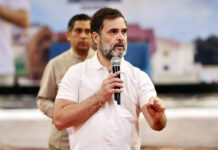G Srinivasan
The services sector now accounts for more than half of the share in aggregate growth of gross domestic product In a season of series of state elections to five assemblies across the country, to be followed by the general election in the summer of 2024, the sense of euphoria on the performance of the domestic economy is quite unsurprising, particularly from the authorities, as reflected in the various official reports for quite some time, glossing over the gaps and structural foibles, characteristic of a high-cost economy like ours. The latest Monthly Economic Review of the Department of Economics Affairs of the Ministry of Finance, released on November 21, lived unto this credo without much ado when it claimed that “with more than half of the current financial year witnessing positive developments in the economy, the full year should conclude as projected with a strong growth performance and macroeconomic stability”, adding that “yet, risks on the downside persist. Inflation is one of them that has kept the government and the RBI on high alert”. Rating agency ICRA, however, is not so euphoric, given the uneven rainfall, narrowing differentials with year-ago commodity prices, the possible slowing down in momentum of government capital expenditure as we approach the parliamentary elections, weak external demand and the cumulative effect of monetary tightening are likely to translate into lower GDP growth in second half of the current fiscal, pushing the growth estimate at six per cent for 2023-24. In stark contrast to this 6 per cent GDP growth for the current fiscal, the Finance Ministry mandarins remain gung-ho in their optimism, highlighting the growth projections of 6.2-6.7 per cent projections of a plethora of agencies, including overseas by pinning their expectations on the government’s sustained investment push, robust corporate profits and a reduction in banks’ non-performing loans to keep investment buoyant, despite elevated input costs.
Be that as it may, independent economists went on record that from 2014-15 to 2021-22, till a year ago when the current fiscal budget gave a massive push to capex in infrastructure development programmes, the eight-year record of the ruling dispensation led by the Prime Minister Narendra Modi witnessed a dismal decline in gross fixed capital formation to GDP ratio at current prices plummeting steadily from 34.3 per cent to 28.9 per cent. This is notwithstanding the fact that its public sector share lingering constant at 8 per cent (National Accounts). It is small wonder that the authorities in the Finance Ministry made no bones about claiming that the government’s emphasis on capital expenditure has continued during the year as well, “imparting an impetus to private investment”, even as corporate investment for expansion of existing plants or building greenfield projects get stuck in the poor and costly credit delivery machinery of the public sector banks for mega projects, analysts say sardonically. As the performance of both primary and secondary sector – agriculture and manufacturing remaining none too encouraging to lift the overall GDP growth into higher position because of the known structural obstacles with which these two vital sectors have been saddled with for far too long, hope hinges highly on the services sector which now accounts for more than half of the share in aggregate GDP growth. It is in this context that a cursory glance at the latest finance ministry review throws up some interesting nuggets especially on the e-commerce front.
Quoting a recent report by Redseer Consulting that estimated India’s e-commerce market to reach $163 billion by 2026 with online sales accounting for over 25 per cent of the sales across major non-grocery retail categories, the review mentioned that this phenomenal growth is likely to be led by the expanding middle-class, accessibility to high-speed internet across Tier-II and Tier-III regions and adoption of recent technology by brands to offer seamless shopping experiences to consumers. This is particularly highlighted in the emergence of e-commerce categories such as home décor and health and pharma which have shown their significance in the digital shopping front, with well-established segments like fashion and accessories and beauty and personal care continuing to show strong evidence to underpin the overall growth of the e-commerce industry. According to the official review, the e-commerce industry is growing on levers such as a surge in smartphone penetration, increased affluence and low data prices, which provide a spur for e-retail growth. The consistent and steady growth observed in fiscal year 2023 underscores the confidence consumers have in e-commerce channel. As per a report by UNICOMMERCE on ‘India E-Commerce Index 2023’, the overall order volume saw a growth of 26.2 per cent in fiscal year 2023, reflecting a refulgent e-commerce landscape in India, supported by a 23.5 per cent rise in annual Gross Merchandise Value (GMV) as compared to fiscal year 22. A blessing in disguise of the pandemic, the review noted, was the lockdown and mobility restrictions which unwittingly drove demand for e-commerce to new highs by bringing new shoppers and sellers aboard on the digital platforms and offering players long-term growth potentials. A related issue to e-commerce examined by the review appertains to the traction gained by private final consumption expenditure (PFCE). Besides boosting robust growth in digital payments, the growth in private final consumption also belies the belief of some commentators that India’s growth might soon soften as PFCE is likely to taper early in the current year ‘as there is no evidence of that supervening so far’. Setting forth a slew of evidence to this effect, the review said that reports confirm that the festive season is keeping the PFCE propped up second, the post-pandemic shift towards services in the consumption basket elicits a quicker supply response than goods; third, the unemployment rate is steadily declining, augmenting disposable income for spending purposes; fourth, the pre-pandemic moderating growth in housing prices has given way to stronger growth, which has generated a substantial wealth effect to induce spending by households who own houses; fifth, a similar wealth effect has emanated from increasing stock market capitalisation; and sixth, surveys show no let-up in PFCE.
The robust increase in consumption evident in key high frequency indicators logging strong growth in the period April-September 2023 compared to the corresponding half of the last year.
Thus, by highlighting two major developments such as the spurt in e-commerce industry’s positive performance and its direct fallout in the form of tangible traction in private final consumption expenditure, the authorities infuse hope that all is not lost on the economic front. But the point to ponder is the debt-laden consumption expenditure fueled by consumer credit boom or the unprecedented uptick in public capital expenditure, mostly on captive borrowing funds, could not be a sustainable proposition in the absence of real sector performance such as the primary, secondary and tertiary sectors, going forward. Productivity improvement in every segment of the real sectors to make abundant use of factors of production such as land, labour and capital is the ineluctable need of the hour to give a real leg-up to growth impulses for a sustained and sustainable recovery story in the years ahead to take due advantage of the demographic dividend India is touted to enjoy now, quip policy wonks wryly.
(G Srinivasan is a senior economic journalist based in New Delhi)




























